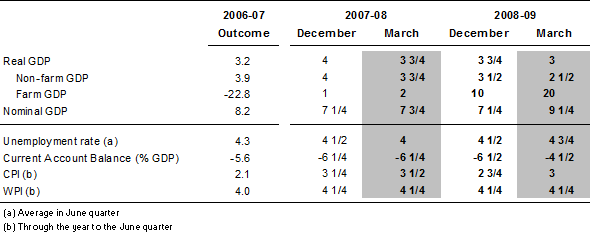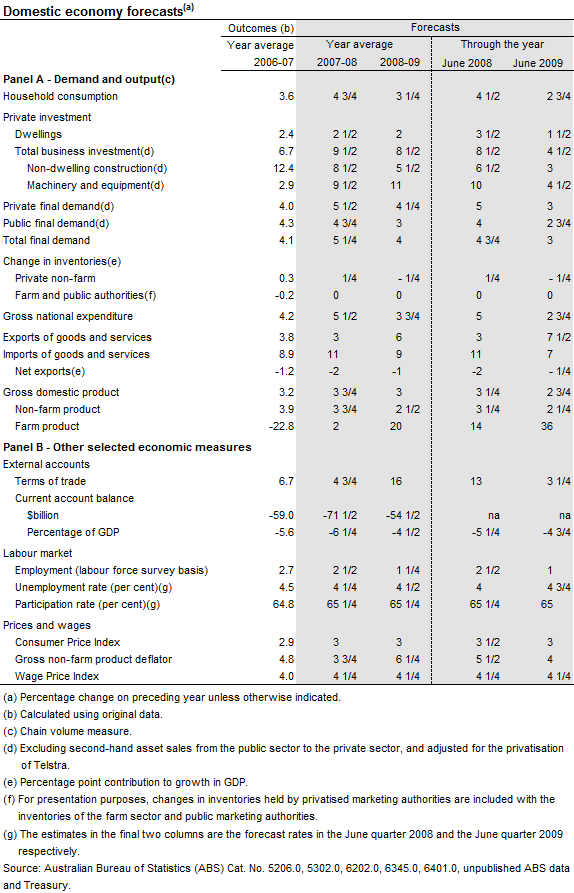While the global economy has remained relatively resilient in spite of worsening conditions in US credit markets, in the last few months financial market stresses have intensified and risk becoming self-reinforcing. At the same time, the economic slowdown in the US and abroad is placing strains on corporate and household balance sheets, and increasing the risk of a global credit crunch. As these events have continued to unfold it is now appears likely that the global economy will slow more significantly than previously anticipated. As a result, world growth is forecast to slow from 4.9 per cent in 2007 to 3¾ per cent in 2008, before staging a slight recovery in 2009
The ongoing re-pricing of risk in world financial markets sparked by the US sub-prime crisis has weakened the outlook for world economic growth, driven by a sharp slowing in the US economy, which is now expected to be in recession in mid-2008. The weakness is being led by the housing market, with February housing permits the lowest since September 1991. While the US Federal Reserve has cut official interest rates aggressively, providers of funds globally are still demanding larger risk premia, particularly for loans with longer maturities. Although some slowing in other advanced economies is expected as a result of US weakness, the outlook for the rest of the world remains largely positive, with China and India expected to continue to post rapid rates of growth over the forecast horizon. Strong growth is also expected in ‘commodity economies’, such as Russia and Brazil, and in the Middle East.
The international financial market turmoil has resulted in a tightening of credit conditions in Australia, as Australian banks have responded to the increased funding costs and more limited availability of credit by raising the interest rate spread on mortgage and commercial loans since the start of the year. This, coupled with a series of official rate rises from a Reserve Bank concerned about strengthening domestic demand growth and rising inflationary pressures, means that consumers and businesses face significantly higher interest rates than at December JEFG. This tightening is expected to place significant downward pressure on Australian economic growth over the forecast horizon.
Countering these moderating influences on the economy are further gains in the terms of trade expected over 2008-09 driven by higher bulk commodity prices. Expectations are for iron ore prices to rise by at least a further 65 per cent and coal prices by around 165 per cent on average from already high levels. This would see Australia’s terms of trade, which has already risen by 40 per cent over the last 5 years, rise by a further 16 per cent over 2008-09, providing a huge additional stimulus to domestic incomes. Some of these gains may be the result of short term supply conditions, for example the effects of flooding on the Queensland coal industry. However, continued demand from China is likely to continue to support a high level of commodity prices in the period ahead.
On balance, these factors result in a weaker outlook for the Australian economy, with real GDP now expected to grow by 3¾ per cent in 2007-08 (¼ of a percentage point lower than December JEFG) and by 3 per cent in 2008-09 (¾ of percentage point lower than December JEFG). The slowing will principally be felt in the non-farm economy, with non-farm GDP now expected to grow by 2½ per cent in 2008-09, a downward revision of 1 percentage point from December JEFG. In contrast, the outlook for the agricultural sector has improved, with farm GDP now expected to grow by 20 per cent in 2008-09, contributing ½ of a percentage point to real GDP growth. The brighter outlook for the farm sector reflects the significant rainfall in the Eastern States over the past few months and the resultant improvement in water storage levels. Although the real economy is expected to slow significantly, the large increase in the terms of trade over 2008-09, and consequently the GDP deflator, will see an acceleration in the value of domestic production, with nominal GDP expected to grow by 9¼ per cent, the fastest since 1989-90. This will provide a significant additional boost to profits in the mining sector in particular.
The downward revision to growth incorporates the impact of higher interest rates and borrowing costs, with growth in domestic demand expected to slow from its present pace by the end of the forecast period, though still remaining solid. At a component level, interest rate rises are expected to weigh most heavily on household consumption and dwelling investment. In contrast, with strong growth in commodity prices, the mining and related sectors are expected to continue to undertake a large amount of investment over the forecast period, leading to only a minor downward revision to the outlook for business investment. While in principle stronger profits in the mining sector should provide an additional spur to investment, mining companies are likely to face capacity constraints in the short run. Sustained higher commodity prices are likely to have more influence on the duration of the current investment boom.
Table 1: Key Domestic Forecasts - March JEFG compared with December JEFG

Source: ABS Cat. No. 5206.0, 6345.0, 6401.0, 6202.0 and Treasury
In line with a forecast slowing in non-farm GDP growth, employment growth is forecast to moderate in 2008-09. In through the year terms, employment is forecast to grow by 2½ per cent to the June quarter 2008, before slowing to 1 per cent in the June quarter 2009, with the unemployment rate rising to 4¾ per cent by the end of the forecast period.
CPI growth is expected to be stronger than forecast at December JEFG, driven by persistent underlying inflationary pressures, in addition to a range of specific factors, such as high oil and food prices. Headline inflation is expected to peak in the March quarter this year and ease gradually to the top of the RBA’s target band by the June quarter 2009.
The CAD is forecast to narrow sharply to 4½ per cent of GDP by 2008-09, having reached 7 per cent of GDP in the December quarter 2007. This narrowing primarily reflects higher prices received on non-rural commodity exports leading to a small balance of trade surplus in 2008-09. Partially offsetting this, higher mining profits associated with higher commodity prices in 2008-09 are expected to lead to a widening net income deficit in 2008-09, as some of these profits are remitted to foreign investors.
While the central forecasts are for a soft landing, the competing shocks create considerably uncertainty around the outlook for the Australian economy. A more marked slowing in the global economy than anticipated, particularly one that involved a slowing in China, or more severe financial market turmoil would see the Australian economy increasingly negatively affected by global conditions. On the other hand, the stimulus from the terms of trade, and the resultant boost in national income could see domestic demand fail to slow as expected, potentially leading to more persistent wage and inflation pressures.
Table 2: Domestic Economy Forecasts(a)
